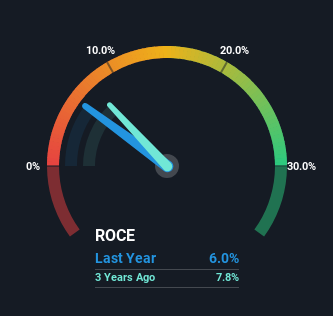- Hong Kong
- /
- Construction
- /
- SEHK:2017
Chanhigh Holdings (HKG:2017) Has More To Do To Multiply In Value Going Forward

Finding a business that has the potential to grow substantially is not easy, but it is possible if we look at a few key financial metrics. Typically, we'll want to notice a trend of growing return on capital employed (ROCE) and alongside that, an expanding base of capital employed. If you see this, it typically means it's a company with a great business model and plenty of profitable reinvestment opportunities. However, after investigating Chanhigh Holdings (HKG:2017), we don't think it's current trends fit the mold of a multi-bagger.
Return On Capital Employed (ROCE): What Is It?
Just to clarify if you're unsure, ROCE is a metric for evaluating how much pre-tax income (in percentage terms) a company earns on the capital invested in its business. To calculate this metric for Chanhigh Holdings, this is the formula:
Return on Capital Employed = Earnings Before Interest and Tax (EBIT) ÷ (Total Assets - Current Liabilities)
0.06 = CN¥64m ÷ (CN¥2.3b - CN¥1.3b) (Based on the trailing twelve months to June 2023).
So, Chanhigh Holdings has an ROCE of 6.0%. Ultimately, that's a low return and it under-performs the Construction industry average of 8.0%.
See our latest analysis for Chanhigh Holdings

While the past is not representative of the future, it can be helpful to know how a company has performed historically, which is why we have this chart above. If you want to delve into the historical earnings, revenue and cash flow of Chanhigh Holdings, check out these free graphs here.
So How Is Chanhigh Holdings' ROCE Trending?
There are better returns on capital out there than what we're seeing at Chanhigh Holdings. The company has employed 32% more capital in the last five years, and the returns on that capital have remained stable at 6.0%. This poor ROCE doesn't inspire confidence right now, and with the increase in capital employed, it's evident that the business isn't deploying the funds into high return investments.
On a separate but related note, it's important to know that Chanhigh Holdings has a current liabilities to total assets ratio of 54%, which we'd consider pretty high. This effectively means that suppliers (or short-term creditors) are funding a large portion of the business, so just be aware that this can introduce some elements of risk. Ideally we'd like to see this reduce as that would mean fewer obligations bearing risks.
The Bottom Line
Long story short, while Chanhigh Holdings has been reinvesting its capital, the returns that it's generating haven't increased. And investors may be expecting the fundamentals to get a lot worse because the stock has crashed 71% over the last five years. Therefore based on the analysis done in this article, we don't think Chanhigh Holdings has the makings of a multi-bagger.
On a final note, we've found 1 warning sign for Chanhigh Holdings that we think you should be aware of.
While Chanhigh Holdings may not currently earn the highest returns, we've compiled a list of companies that currently earn more than 25% return on equity. Check out this free list here.
If you're looking to trade Chanhigh Holdings, open an account with the lowest-cost platform trusted by professionals, Interactive Brokers.
With clients in over 200 countries and territories, and access to 160 markets, IBKR lets you trade stocks, options, futures, forex, bonds and funds from a single integrated account.
Enjoy no hidden fees, no account minimums, and FX conversion rates as low as 0.03%, far better than what most brokers offer.
Sponsored ContentNew: AI Stock Screener & Alerts
Our new AI Stock Screener scans the market every day to uncover opportunities.
• Dividend Powerhouses (3%+ Yield)
• Undervalued Small Caps with Insider Buying
• High growth Tech and AI Companies
Or build your own from over 50 metrics.
Have feedback on this article? Concerned about the content? Get in touch with us directly. Alternatively, email editorial-team (at) simplywallst.com.
This article by Simply Wall St is general in nature. We provide commentary based on historical data and analyst forecasts only using an unbiased methodology and our articles are not intended to be financial advice. It does not constitute a recommendation to buy or sell any stock, and does not take account of your objectives, or your financial situation. We aim to bring you long-term focused analysis driven by fundamental data. Note that our analysis may not factor in the latest price-sensitive company announcements or qualitative material. Simply Wall St has no position in any stocks mentioned.
About SEHK:2017
Chanhigh Holdings
An investment holding company, provides landscape and municipal works construction and maintenance services in the People’s Republic of China and Hong Kong.
Flawless balance sheet and good value.
Market Insights
Community Narratives



